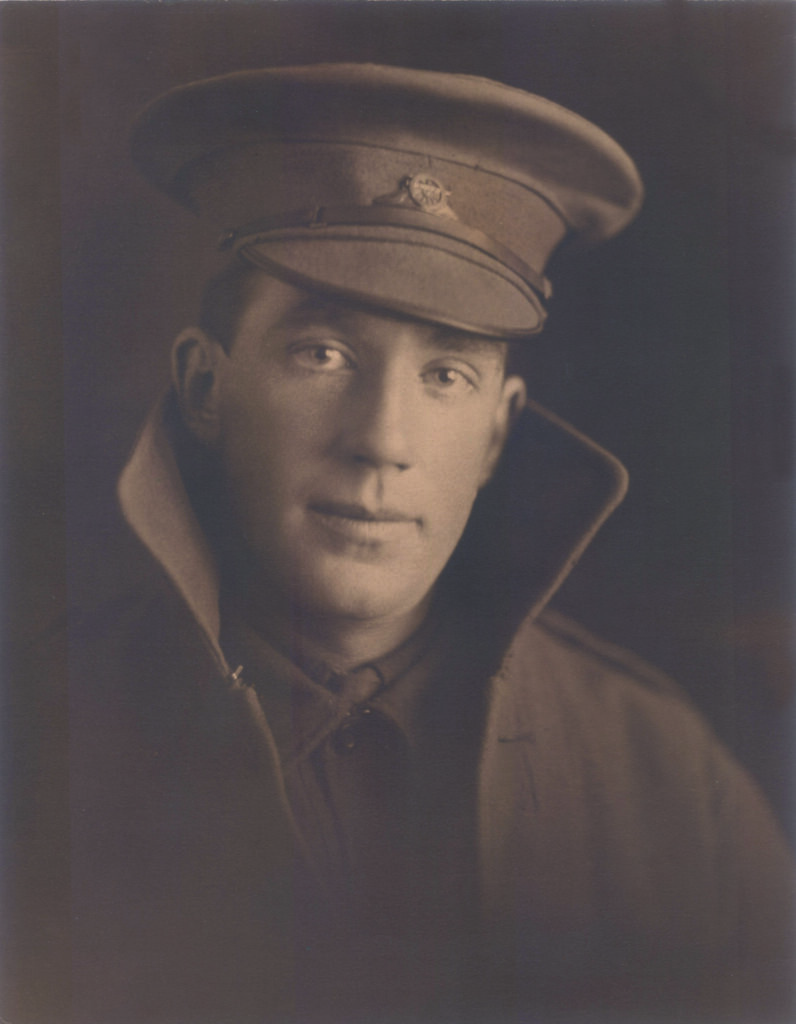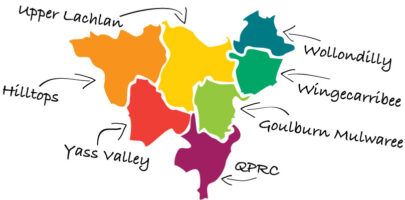Robert Lewis Muir: Great Southern Line
Started work for NSWGR in Goulburn as a casual engine cleaner in 1915 at the age of 22 and enlisted in early 1916 with four others from Goulburn Loco Dept. Served in France and Belgium as Driver in Field Artillery, Motor Transport and Field Ambulance. After his discharged in 1919 he was employed as a Fitters labourer in Goulburn Loco Dept. In 1935 he was promoted to Fitters’ Assistant and held this position until he resigned in 1947 so that he and his wife could visit family in England.
Note that as a casual employee he may not have been eligible for the difference between military and railway pay, nor would his position have been held for him. It is likely that he was re-employed rather than reinstated by NSWGR.
Born in Glasgow 1893. Family emigrated to Australia in 1912 when he was 19. He worked on the construction of Burrinjuck Dam from 1913 until employment on Railway. He was 22 and single when he enlisted.
Robert was not hospitalised during his service but like his co-driver in the field Ambulance was exposed to mustard gas. Like many he did not want to delay his repatriation with medical tests, and there is no record of this on his service record. His death from pneumonia in 1963 at the age of 70 suggests the lung damage he suffered.
Robert and his co-driver in Field Ambulance met their future wives in Pozieres – two friends who were serving with the UK forces, officially as cooks but often helping the wounded. Robert and Jean’s son Ron was born in Wales in 1920 after Robert had returned to Australia. Ron remained with Jean’s family when Jean joined Robert in Australia and married him in 1922. They had three daughters. Family and financial circumstances made it impossible for Ron to come to Australia as planned.
During the Depression Years Robert’s hours as a fitter’s Labourer were reduced
During the Second World War Robert and Jean ran the ‘Daffodil café’ in Auburn Street for troops on leave in Goulburn.
The Story as told by Jeanette and Robyn Cummins to Dr Mary Hutchison
We can remember staying school holidays and some weekends with Nan and Pop at Narrabeen. He would play hide and seek with us and always pretend that he couldn’t find us for quite some time. There were always cuddles when he did find us. In school holidays Pop and Nan would walk us from Narrabeen Heights to the beach and sometimes to the bus in Narrabeen and then on the bus to Manly. We recall helping him tear up the phone book to use as toilet paper in the ‘dunny’ while the house was still under construction. At first we stayed in the caravan with them and later in the lower, first stage of the house as it was built, and finally in the finished home.
We remember Pop making the pots to sell, but then Nana wanted to keep them all. He made toys for us. In particular we recall him making a plane for our brother Bruce who was just over 2 at the time. He used wood off cuts to make the body, wings and tail for the plane, and painted it cream. Then he used bottle-tops, that he had painted blue, as windows and he used little rubber wheels on brackets for the front wheels and he drilled a hole in a penny to make the back tail wheel. We recall being scared he would get in trouble with the police because he had defaced a coin! We loved him to bits.
We recall Pop, when he stayed with us or us with him, making us breakfast and using the little antique jug for our milk. He would cook us porridge and at first wanted to strain it for us as our Mum had never liked lumpy porridge so he had always strained it for her.
We both recall his patience in teaching our aunt to drive, even when she backed over our clothesline when he was teaching her to reverse in our back yard!
Jeanette particularly remembers going with our Mum to watch the ANZAC march in Sydney and meeting Pop afterwards in Martin Place. Sometimes he stayed and had a picnic lunch with us and sometimes he might go and meet his remaining friends from his unit. He never stayed drinking for too long or Nana would be cross with him.
Robyn can vaguely remember him giving us piggy backs in the back area of the shop where they lived in Hornsby. Our Mum was staying with her parents when Robyn was due and Pop delivered her at home.
Robyn recalls our last visit to our grandparents on the Sunday before Bert died. He wanted to see us kids but was concerned that we didn’t catch his cold as it was a bad one. He blew kisses to us from his bed.
At the time of his death, Jeanette was 12 and Robyn 10 years old.
Notes on the conversation between Robyn Cummins and Dr Mary Hutchison.
Robyn is the daughter of Dot Edgar, daughter of Robert Muir. Robert died when Robyn was 10 so she has clear memories of him and Dot has passed on many stories of the Muir family.
Robert Muir, his wife and family lived in Goulburn after the War until 1947 when Robert and his wife sold the house in order to go to the UK and visit their first son who had remained there after he was born.
- Dot has the photo of the five railway friends who enlisted (seated with backdrop). William Guthrie’s name is particularly familiar because of his sister, Sister Guthrie, whose house was a maternity home (Sister Guthrie married Robert Curtis)
- When Robyn took the photo for specialised scanning, the photographer was particular interested in Robert Muir and made a sketch of him from the photo. Robyn has a copy of this.
- Robert worked on the railway at Menangle as well as Goulburn before he enlisted. His friends at Menangle gave him a gold watch as a farewell gift. Robyn’s brother now has the watch (in Qld).
- Robert is remembered as someone who had great strength of will and stood up for people’s rights. He always marched in May Day celebrations. Robyn has an image from the Goulburn Evening Penny Post of one such march
- Robert met his future wife, Jean Edwards, at the Somme. She was from a coal mining village in South Wales. She and her younger sister had enlisted as cooks for the British Officers, but with lack of experienced nursing staff they ended up looking after wounded men. Like Robert she had a strong sense of the rights of the underdog and hated the class distinction between officers and men that she saw on the battlefield – such as the officers eating extremely well in relatively comfortable quarters, while the men froze and starved in the trenches.
- Robert did not get on well with his commanding officer – this is reflected in a couple of incidents recorded in his service record. Both suggest his independent attitude and refusal to be bossed around.
- There is a photo of Jean and her sister friend Marie Roberts, ‘Bobbie’at the Somme and another of Robert and his friend Alec McKinnon (also from Goulburn but not a railway worker) who married Jean’s sister friend
- Robert and Jean did not marry until they were in Australia. Their first child, Ron, was born during the War and they could not afford his passage back to Australia, especially as the Depression set in and Robert was working two weeks out of every three. Ron was brought up by Jean’s family.
- Both Robert and Jean suffered the effects of mustard gas poisoning. Robert was so keen to get away from the army and back to Australia that he did not have a final medical test, so in later life he was unable to get a military pension on health grounds. The terrible cold and general conditions of the Somme also had an impact on their bodies and both of them had severe arthritis in their later years.
- They were also more generally affected by the horrific battlefield situation and both suffered in various ways from what we now call PTSD. In Jean’s case this was reflected as a degree of brittleness in her nature and reactions to situations and people.
- Robert had great resilience and both he and Jean throughout their lives not only strived and made do so that they could bring their family up as well as possible, but helped others. During the Depression they supported people selling items door to door and during the Second World War ran the Daffodil Café to host British Troops on leave. They kept the café open until the last train into the station had arrived.
- They grew their own vegetables and made the most of their two bedroom house in Sloane Street by enclosing the front verandah and taking in a boarder, Robbie, who slept on the back verandah.
- Robert and Jean both had strong local accents and were regarded as ‘foreigners’ by people in Goulburn.
- Details of important dates in Robert’s life – his arrival in Australia, dates of photos etc – were recorded by Robert in a small diary
Note re: Robert’s employment record
Robert’s employment card records his permanent employment with the Railway from his return from the war (1919). There is a note that he was previously casually employed as an engine cleaner that does not mention location. This means that he may not have been eligible as permanent employees were to have his military pay topped up to his railway pay. It also means that he may not have been guaranteed of a job on his return. On his service record his occupation is given as fireman. Fireman was a step above engine cleaner.

Cleaner, Fitter’s Assistant
Goulburn
War Service record: NAA B2455, (service no. 25677)
NSWGR Employment Card: NSW Public Records staff no. 53639
Granddaughters: Robyn and Jeanette Cummins
STA MEMBERSHIP
free & connects you to the STA universe
Reach out to us
[email protected]
0427 938 110
Or by appointment at one of our
Mobile Office locations
PO Box 1323 Goulburn 2580
ABN 67 208 214 681
We acknowledge Aboriginal people as the traditional custodians of the lands where we create, live & work.
© Southern Tablelands Arts. All Rights Reserved




